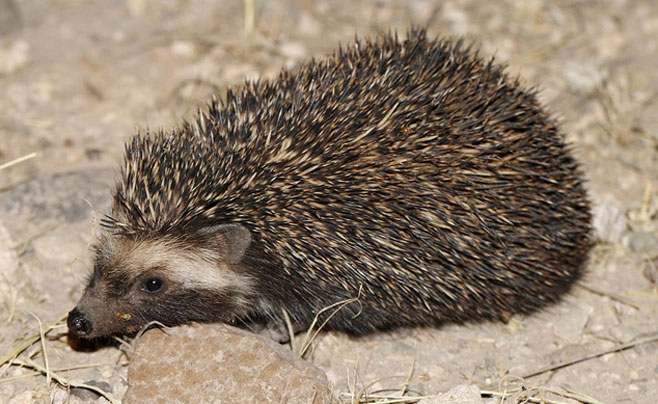|
Atelerix frontalis (South African hedgehog)
hegehog [English];
krimpvarkie, Suid-Afrikaanse krimpvarkie [Afrikaans];
Südafrikanischer Igel [German];
hérisson d' Afrique du Sud [French]; inhloni [isiNdebele] [isiZulu];
intloni, umahau [isiXhosa]; thlong, hlong [Sepedi];
thlong [Sesotho];
tlhông, setlhông [Setswana];
shoni [Sho];
indvundvundvwane, indvundvwane [siSwati];
nhloni, xitlhoni, xihloni [Zitsonga];
tshitoni, thoni [Tshivenda];
!Noaros [Nama] [Damara]
Life
>
Eukaryotes >
Opisthokonta >
Metazoa (animals) > Bilateria > Deuterostomia >
Chordata > Craniata > Vertebrata (vertebrates) >
Gnathostomata (jawed vertebrates) > Teleostomi (teleost
fish) > Osteichthyes (bony fish) > Class:
Sarcopterygii (lobe-finned fish) > Stegocephalia
(terrestrial vertebrates) > Reptiliomorpha > Amniota >
Synapsida (mammal-like reptiles) > Therapsida > Theriodontia
> Cynodontia > Mammalia (mammals)
> Placentalia (placental mammals) > Laurasiatheria
> Eulipotypha (shrews and hedgehogs) >
Family: Erinaceidae (hedgehogs)
 |
|
Atelerix frontalis (South African hedgehog),
Palmwag, Namibia. [photo
Dan
Rosenberg ©] |
See
Flickr for the original image.
Identification
The small body size and body covering of sharp
spines are characteristic of the hedgehog. The spines typically 2-3
cm long, are modified hairs that extend from the forehead to the
back of the rump. They are white at the base and the tip with a
dark-brown or black band in the middle. The underside of the animal,
its face, legs and tail are covered in hair.
Size
Body length 20cm and body mass of 400g.
Distribution and habitat
Two separate populations in southern Africa,
one in Namibia and the other extending from the eastern Cape north
to Zimbabwe and eastern Botswana. Found in a wide range of habitats, but not in
desert or high-rainfall areas.
General behaviour
Hedgehogs are solitary animals and are
primarily nocturnal, during the day they rest amongst dry vegetation
and leaf litter or in the burrows of other species. They hibernate
during the cold winter months, although they need to wake up
regularly every few weeks to feed and urinate.
When alarmed hedgehogs rollup in a tight ball,
with the spines protecting the vulnerable head and underparts.
Well-developed muscles just beneath the skin tighten the skin around
the body, erecting the spines. This defense is so efficient that
hedgehogs have few natural predators. Some of the larger owl species
are efficient hedgehog predators and are able to “shell” the
hedgehog with their large claws. Although hedgehogs usually move
around slowly they are capable of moving quickly when the rise up on
their long legs.
Food
Varied diet includes large proportion of
invertebrates (such as insects, millipeds, earthworms, etc), mice,
lizards, fungi and some fruit.
Reproduction
Hedgehogs are born after a 35 day long
gestation period with the spines just below
the skin. This is to prevent damaging the mother’s birth canal. The
white spines emerge from beneath skin within a few hours of birth. Up to
nine young may be born in a litter but the average is four, the
young are deaf and blind at birth. By six weeks they have a set of
adult spines and are ready to be weaned.
Life span
6-7 years
Conservation
The numbers of hedgehogs have declined in some
areas, this is probably due to a combination of the following
factors, use of the skin and spines for traditional medicine, road
mortality, predation by people, capture for pets, habitat
destruction, harmful farming practices and maybe climatic factors
too.
|
